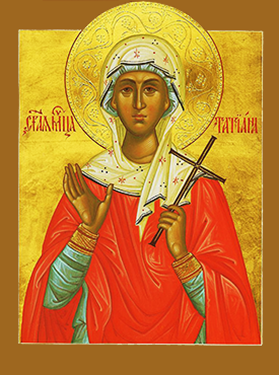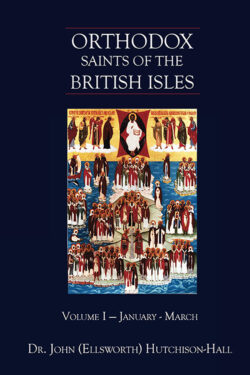
Orthodox Saints of the Pre-Schism
See of Rome
25th January (NS) — 12th January (OS) 2024
ARCADIUS, a distinguished Christian member of society in Cæserea the capital of Mauritania Caesariensis (present-day Cherchell, Algeria) who went into hiding during a period of persecution. The authorities arrested a member of St. Arcadius’ family, threatening to torture him unless St. Arcadius surrendered. St. Arcadius presented himself to the authorities forthwith, and was told all would be released if he would simply make a public sacrifice to a pagan god. St. Arcadius rejected the offer and was slowly hacked to death, circa 302.
BENEDICT BISCOP, St. Benedict Biscop was a Northumbrian of noble birth, who spent his youth at the court of King Oswiu. Returning from his second pilgrimage to Rome, 666, he became a monk at Lérins. Three years later, he accompanied St. Theodore (19th September) to Canterbury, where he became Abbot of the monastery of SS. Peter and Paul (later St. Augustine’s). He went on to found the monasteries of St. Peter at Wearmouth (674) and St. Paul at Jarrow (682). St. Benedict was an ardent advocate of Roman liturgical practice, and was well known for his enthusiasm for art and learning, returning from each of his five trips to Rome with numerous paintings, relics, and manuscripts. He was responsible for bringing John the Archcantor of St. Peter’s in Rome to England to teach Roman chant, and is said to have introduced the use of glass windows and stone in the construction of English churches. St. Benedict’s Life was written by St. Bede the Venerable (25th May), who was St. Benedict’s charge from the age of seven.
CAESARIA, the sister of St. Cæsarius of Arles (27th August). Her brother appointed her Abbess of the Monastery of St. John which he had founded, and during her tenure the community grew to several hundred nuns. SS Gregory of Tours (17th November) and Venantius Fortunatus (14th December) described her as possessing outstanding gifts, St. Caesaria was renowned for her devotion to the poor, sick, and children. St. Caesaria reposed circa 530.
JOHN of RAVENNA, the Bishop of Ravenna in Emilia-Romagna from 452 until his repose in 494. St. John is remembered for protecting his flock from the savagery of Attila the Hun and secured better conditions for Ravenna after it had been occupied by Theodoric the Great, King of the Ostrogoths (r. 475–526).
PROBUS, a late sixth century Bishop of Verona of whom nothing further is known.
TATIANA and COMPANIONS, a renowned virgin-martyr from a prominent Roman family, and most likely a deaconess. St. Tatiana and others were martyred the persecutions during the reign of Emperor Severus Alexander, circa 226.
VICTORIAN of ASAN, a founder of monasteries and hospices in Italy. St. Victorian travelled west, spending time in France, and then to the Spanish Pyrenees where he founded and served as first abbot of a monastic community at Asan, now known as Monasterio de San Vitorián. St. Victorian reposed circa 560.
ZOTICUS, ROGATUS, MODESTUS, CASTULUS, and COMPANIONS, (Date Unknown), a group of forty to fifty soldiers martyred in North Africa. Nothing further is known of them.
Get your copy of Orthodox Saints of the British Isles today.
Available at Amazon or your favourite e-bookstore.
AMARINUS, abbot of a monastery in the Auvergne (Gaul), a friend and confidant of St. Praejectus, twenty-fifth Bishop of Clermont (vide infra), whom he was martyred with in 676.
ARTEMAS, (Date Unknown), a Christian youth who lived near Naples and was martyred by his schoolmates.
DWYNWEN, a Welsh saint believed to have been a daughter of King St. Brychan of Brycheiniog (6th April) , churches dedicated to her are to be found in Wales and Cornwall. Her holy well and shrine at Llanddwyn Island (Ynys Môn) in Anglesey were once centres of pilgrimage. After a troubled life, she reposed circa 460.
EOCHOD, known as the Apostle to the Scots and Picts in Galloway, St. Eochod was one of St. Columba of Iona’s (9th June) twelve companions when he travelled from Ireland to Scotland. There is no reliable information on his life extant; however, it is thought that he was chosen to preach in northern England and Galloway.
POPPO, a deeply devout and God-fearing monk of noble ancestry. St. Poppo's sanctity and probity, led to him being placed as abbot or prior of several monasteries in present-day Belgium and France. Often these houses were in need of restoration of order and religious observance, and the revival he had brought about spread to other monasteries throughout present-day Germany, France, and Switzerland. St. Poppo reposed of natural causes in 1048.
PRAEJECTUS, the twenty-fifth Bishop of Clermont in the Auvergne (Gaul). St. Praejectus was close friends with St. Amarinus (vide supra), with whom he was martyred in 676.
RACHO (RAGNOBERT), the first Bishop of Autun who reposed circa 660. Nothing further is known of his life.
SIGEBERHT, the first Christian King of the East Angles (r. 630/1–654). The principal source for King St. Sigeberht's life is St. Bede the Venerable (25th May), from whom we learn that he was the first English king to receive a Christian baptism and education before his succession, as well as the first to abdicate in order to enter the monastic life. With the help of St. Felix (8th March), the founder of the See of Dunwich, and St. Fursey (16th January), St. Sigeberht induced his subjects to embrace Christianity. By the time Penda of Mercia threatened the East Anglians, he had retired into a monastery; but his people recalled St. Sigeberht, and he fell in battle (635). As he was fighting against Pagans, he was venerated as a martyr.
THORGYTH (TORTGITH), the novice-mistress of Barking Abbey under St. Etheldreda of Ely (23rd June), and friend of its founder, St. Ethelburga (11th October). St. Thorgyth was known for her zeal and care for the young. She was described as a miracle of patience under suffering, as she is reputed to have suffered paralysis for six years and experienced a vision of Ethelburga just before the abbess’s death. St. Thorgyth reposed circa 700.
Prior to the Schism the Patriarchate of Rome was Orthodox, and fully in communion with the Orthodox Church. As Saint John of Shanghai and San Francisco +1966 said “The West was Orthodox for a thousand years, and her venerable Liturgy is far older than any of her heresies”.
Details of British Saints excerpted from Orthodox Saints of the British Isles.
Details of continental saints from these sources.
In many cases there are several spelling versions of the names of saints from the British Isles. I use the Oxford Dictionary of National Biography version as the primary version with the more prevalent version in parenthesis e.g. Ceadda (Chad) of Lichfield.


